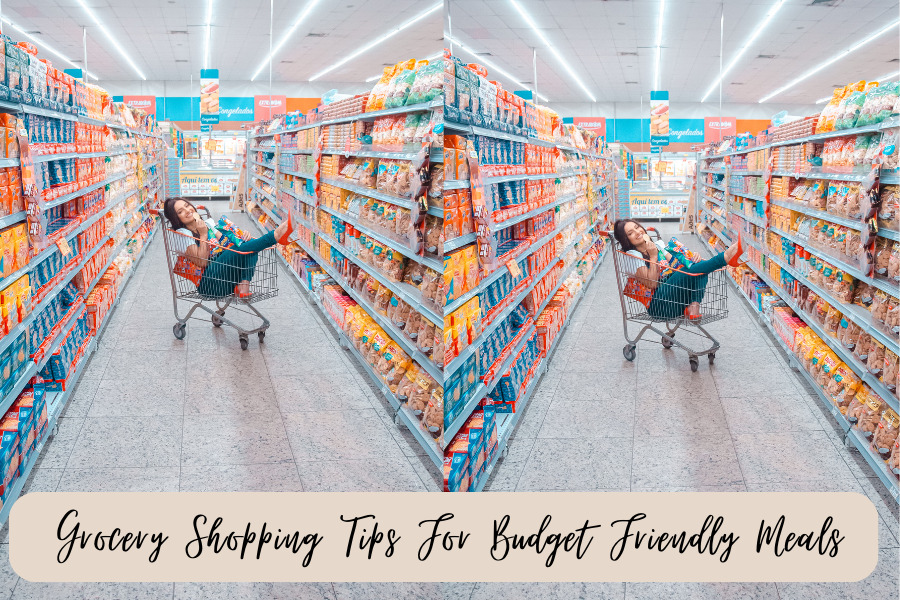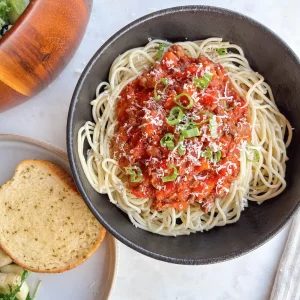I am so excited to share my Grocery Shopping List and Tips For Budget-Friendly Meals! I am very familiar with budget-friendly meals and (not to brag but) I’m kind of a grocery-shopping pro. Here are my best tips for grocery shopping on a budget with a grocery shopping list FREE download at the end!
Food costs are inevitable (food is one of our basic needs after all). Whether you are shopping for 1 or a family of 6, budget-friendly meals are always welcome. They help you stretch your dollar and (hopefully) free up some dollars to spend on wants rather than only your needs.
Lucky for you, I am kind of a grocery shopping pro (weird flex?). But seriously, I have extensive experience cooking at all price points. I remember spending less than $50 per week at the grocery as a college student. That budget stuck with me even after graduation while I was working my first (real) job. I have worked within many budgets for my clients and family. Let me tell you – my superpower is the ability to take a little money and turn it into a whole lot of meals.
In this blog, we will cover my best tips for saving those dolla dolla bills y’all. I will link my favorite budget-friendly meals on the blog AND include a free downloadable grocery shopping list at the end!
This post is all about budget-friendly meals & includes a grocery shopping list!
1. Don’t Go To The Grocery Store Hungry
You’ve heard it before, but I’ll say it again – don’t go to the store hungry. You will veer off your list & your budget if your eyes are bigger than your stomach. Make sure to fuel up before!
2. Use What You Have
Got some frozen salmon fillets? Plan a meal around it! Got some canned tomatoes collecting dust in your pantry? Plan a meal around it! You will be surprised at how much money you can save by getting creative with what you have already!
3. Have A Plan
Spend some time planning out what you will make this week. Make a list of everything you will need. Then cross-check that list with what you have on hand! Check out these meal prep tips for help with meal planning!
[the_ad_placement id=”manual-placement-in-blog-feed”]
4. Know Your Budget
Are you looking to stay under $40 or $300? Know your budget and stick to it.
[the_ad id=”3378″]
5. Keep It Simple
If you make a new dinner every night, it can get more expensive because there are more ingredients involved. I recommend cooking large batches of food (cook once eat twice). Not only does it cut down on the ingredients that you need to shop for, but it also cuts down on time spent in the kitchen and allows you to buy in bulk (saving you more money by buying in bulk).
I usually choose 1-2 breakfast options and 3-4 dinner options for the week. Usually, leftover dinners become lunch in our household, but occasionally I will make 1 lunch recipe (or simply make sandwiches!). You can fill in the gaps from there with snacks (I like to bake one snack for the week like muffins or banana bread)!
6. Shop In Season
When produce is in season, it means there is usually an abundance. And the law of supply & demand would tell us that when there is an overabundance, the price goes down. But when it’s “slim pickin’s” the price goes up. Just think back to early 2023 when there was an outbreak that killed a substantial amount of egg-laying hens. The availability of eggs suddenly plummeted, and egg prices soared 60%! Lucky for us, once new hens were born and production resumed to normal, the price dropped again. Supply & demand at its finest!
Shopping in season (and using that extra supply to your advantage) can help you save on your grocery bill! Small things like this can make a big difference in your total grocery spending for the week. For a full list of seasonal produce, click here!
[the_ad_placement id=”manual-placement-in-blog-feed”]
7. Fresh vs. Frozen vs. Canned
Canned & frozen varieties tend to be more affordable than fresh. Plus, they won’t go bad as quickly. Remember: food waste = money waste. I recommend buying a mix of fresh, frozen, and canned produce. If you only buy fresh, odds are some things will go bad before you get around to them. So, be strategic in your purchase of fresh produce & fill in the gaps with frozen & canned varieties.
8. Shop The Sales
Sometimes, the sales are seasonal – but sometimes they aren’t! Each week at Aldi (where I shop), there are typically 3-4 produce items on “deal” that week. If I planned on making a side of asparagus with dinner but the zucchini is on sale – that plan just changed to a side of zucchini. If I had raspberries on my list but blackberries were on sale, looks like we are having blackberries this week! If you can make an easy swap to save a few bucks, do it. It all adds up!
9. Price per lb or price per oz
We are trained to do this with meat (because it is usually sold by the pound), but have you ever stopped to look at the price per oz of things like rice or pasta? If one box of pasta is $1.25 and contains 1 lb of spaghetti but another box of pasta is $1.50 and contains 2 lbs of spaghetti – the $1.50 spaghetti is the better deal.
Pay special attention to the price per oz and use it to maximize your dollar at the grocery store.
[the_ad_placement id=”manual-placement-in-blog-feed”]
10. Buy In Bulk
This point goes along with the point above. Buying the family pack of chicken, for example, costs less per pound. If you know you won’t get through all that chicken in a week, freeze half of it immediately when you get home and use that second half the following week. Dollar = stretched!
[the_ad id=”3378″]
11. Eat More Meatless Meals
Beans and lentils are SUPER cheap and add plant-based protein to your meals. You can buy them dry or canned, they won’t go bad, and they will cut down on your meat costs!
Need Some Meatless Ideas?
Click here for all of my vegan recipes.
Click here for all of my vegetarian recipes.
12. More Scratch Cooking, Less Convenience
While I’m 100% on board with having a few convenience meals on hand, convenience typically comes with a price. Plan out your week and make time to cook from scratch more often to help stretch that dollar.
However, it doesn’t hurt to have a frozen pizza or two on hand when you don’t have time to cook. A frozen pizza is still cheaper than takeout. If you are on a tight budget, eating homemade meals will be your best option! Trust me!
[the_ad_placement id=”manual-placement-in-blog-feed”]
13. Shop at Aldi!
I used to be a Trader Joe’s girl. But the Aldi business structure is built to save you money. I would argue that Aldi is cheaper than Sam’s even though Sam’s is famous for its bulk savings. I recommend getting as much as you can from Aldi (if you have one near you) and fill in the gaps at another store (if needed).
[the_ad id=”3378″]
My Favorite Budget-Friendly Recipes
[convertkit form=5634205]
[the_ad_placement id=”manual-placement-in-blog-feed”]
This post was all about budget-friendly meals & includes a grocery shopping list.
Did you try these tips? Make sure to tag me @thespicegirlkitchen_ on Instagram or @thespicegirlkitchen on TikTok! I love seeing you CRUSH IT! I will be your ultimate hype woman!
Want to learn more about Kelsey? Click here to read her story!








Great content!! Love your tips!!
Thank you!!